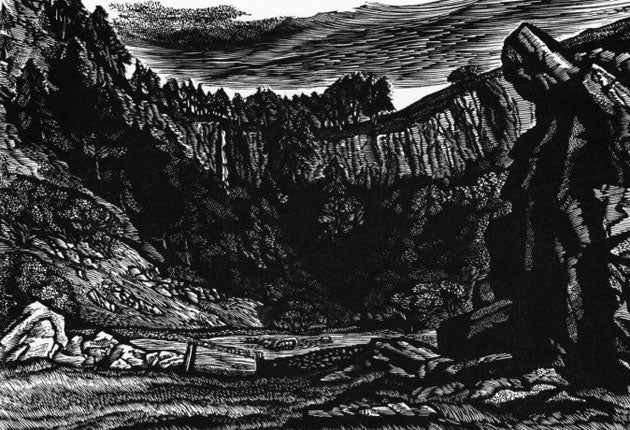Peter Reddick: Award-winning wood engraver who illustrated numerous books for the Folio Society and Penguin

Peter Reddick was an artist and illustrator who used the wood-engraving technique developed by Thomas Bewick and his successors from the end of the 18th-century onwards. He used the end grain of the wood (typically a very hard wood such as boxwood) to make his incision, whereas the traditional woodcut is made using the softer side-grain. The resulting image has the potential for great sharpness, depth, and intensity. Edward Hodnett in Five Centuries of English Book Illustration said of Reddick: "His success stems from the unusually conscientious effort he makes to clothe imaginary characters and places in the semblance of reality. He takes pains to particularise faces and make them interesting. Then he transforms the traditionalism of his approach by means of bravura wood engravings."
Reddick was born in Essex in 1924. His parents were members of the Society of Friends and at the age of 16 he too joined the Society: the values instilled in his youth permeated the rest of his life. After attending the Royal Liberty School in Gidea Park, from 1941 to 1942 he went to study at the South East Essex technical college and school of art until, at the age of 18, he registered as a conscientious objector and spent the Second World War doing land work.
At the end of the war he continued his studies at Guildford and Cardiff schools of art and then from 1948 to 1951 at the Slade School of Art in London under Norman Janes and John Buckland Wright. By now married, Reddick found it impossible to make a living as an illustrator so he took a job as a visiting tutor at the Regent Street polytechnic in London.
In 1958 he contracted polio, which limited his ability to work, so he took a course at the London School of Printing in order to focus on design and typography. In 1960 Reddick took up a lectureship in Commercial Design at the Kumasi college of science and technology in Ghana, but returned home two years later to teach design at Glasgow school of art. From 1967 until his retirement in 1989, he taught illustration in the department of graphic design at Bristol polytechnic.
Reddick's first influences were the English Romantic engravers and their 20th-century successors, artists like Blair Hughes Stanton, Gertrude Hermes, Edward Bawden and Eric Ravilious. He called his early engravings the work of a "romantic ruralist", and the intense feelings he had for the land and the coast, their natural shapes and textures, never ceased to inspire him. Hilary Paynter, the Chairman of the Society of Wood Engravers, wrote in the Society's journal not long before Reddick's death of how, as a student in the 1960s, his work had been a revelation to her: "I found Peter's work electrifying. I still do... There is something about the way he animates his lines and textures even within a formal portrait that draws one right into the heart of the engravings."
Reddick's output as an illustrator was substantial. From 1963 onwards, beginning with John Donne's Poems of Love, he was invited to contributea significant amount of work for the Folio Society. His intense, dramatic style was particularly suited to the works of Thomas Hardy and he illustrated seven of Hardy's novels (his1971 engravings for The Return of the Native won a Francis Williams Illustration Award). Among other works for the Folio Society he illustrated Crotchet Castle by Thomas Love Peacock, Anthony Trollope's Barchester Chronicles, Shakespeare's King Lear and Richard III, and James Hogg's Domestic Manners and Private Life of Sir Walter Scott, as well as engravings of poets from Shakespeare to Gerald Manley Hopkins.
Work for other publishers included portraits of famous scientists for the Cambridge University Press, the cover designs for the 1960s Penguin edition of Daphne du Maurier's novels, Robert Browning's Poems for the New York Limited Editions Club, Folklore, Myths and Legends for Reader's Digest, and The Forgotten Arts, published by Dorling and Kindersley.
In 1982 the National Museum of Wales commissioned from Reddick six engravings of the Slate Quarrying Museum in Llanberis and 12 engravings of the St Fagans Museum the following year. Reddick's work is held in institutions that include the Victoria and Albert Museum, Bristol Museum and Art Gallery and the National Library of Wales in Aberystwyth.
Reddick also made a number of pictorial labels and book plates. In 1953 he was elected to the Society of Wood Engravers, in 1970 to the Royal Society of Painter-Printmakers, and in 1991 to the Royal West of England Academy; he exhibited regularly with them all. He participated in many shared exhibitions and, as a Gregynog Arts Fellow, a one-man show of his work toured Wales during 1981 and 1982, and another one-man retrospective toured Wales in 1988 and 1989. His work for design groups includes engravings for Saatchi and Saatchi.
Peter Reddick was a tall, quiet man of great personal sweetness, always willing and generous with assistance and advice. He was a founder-member of the Bristol Artspace and the Spike Island Print Studio. Keen topromote print for college leaverswithout access to print facilities, he gave his time, building the equipment himself. He continued to teach wood engraving at the studio until he was in his eighties.
Reddick's work appears in The Illustrators at Work by Robin Jacques, The Woodblock Engravers by Kenneth Lindley and The History of British Wood Engravers by Albert Garrett. In 1994 Professor Ian Rogerson compiled Peter Reddick, Draughtsman, Wood Engraver, Illustrator. Rogerson also oversaw the transfer of Reddick's archive to the Sir Kenneth Green Library at Manchester Metropolitan Library.
Peter George Reddick, artist and teacher: born Upminster, Essex 5 June 1924; married 1951 Liz Dawson (died 2005; two sons, one daughter); died Bristol 28 September 2010.
Join our commenting forum
Join thought-provoking conversations, follow other Independent readers and see their replies
Comments